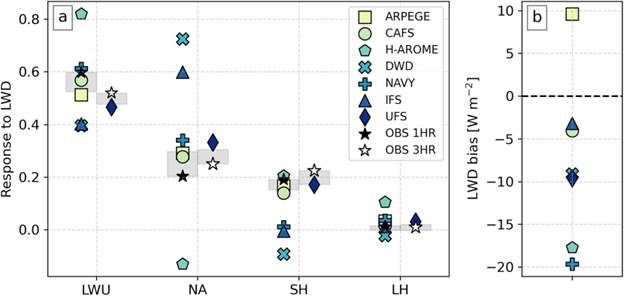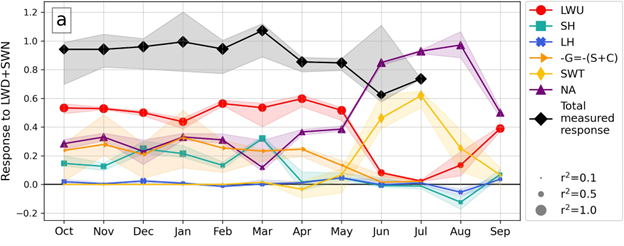Arctic Surface Energy Partitioning Depends on Season and Sea Ice Thickness
Submitter
Shupe, Matthew — University of Colorado
Area of Research
Surface Properties
Journal Reference
Sledd A, M Shupe, A Solomon, and C Cox. 2025. "Surface Energy Balance Responses to Radiative Forcing in the Central Arctic From MOSAiC and Models." Journal of Geophysical Research: Atmospheres, 130(6), 10.1029/2024JD042578.
Science

Figure 2: (a) Response of surface fluxes to radiative forcing during winter months (no solar radiation) from observations (OBS) and multiple operational weather forecast models. Observed relationships are shown using two different time averages to match the models within a given column (stars), while the range of observed relationships captured by different sites is given as gray shading. During winter, radiative forcing is simply the downwelling longwave radiation (LWD) and the net atmospheric flux (NA) is equal to the conduction at the surface. Other responding flux terms are the upwelling longwave radiative flux (LWU) and turbulent sensible and latent heat fluxes (SH, LH). (b) The bias of LWD during winter for each model compared to the observations.

Figure1: Annual cycles of the flux responses to radiative forcing (downwelling longwave and net shortwave radiative fluxes). Markers are the mean best-fit linear slope between the total radiative forcing and the responding variable of interest across multiple sites, while the shading represents the variation among mean relationships for individual sites. The size of each marker is proportional to the mean r2 value of the best fit line for the month. The total response is calculated by regressing the sum of measured fluxes against the radiative forcing. Fluxes include the upwelling longwave (LWU), sensible and latent heat (SH and LH), subsurface flux (G) that depends on storage (S) and conduction (C), transmitted shortwave radiation (SWT), and the net atmospheric flux (NA = SWN + LWN – SH – LH).
The surface energy budget couples the atmosphere with the annual evolution of sea ice. Direct measurements from the Multidisciplinary drifting Observatory for the study of Arctic Climate (MOSAiC) have been used to derive a yearly cycle of surface energy budget process relationships that are used to characterize the seasonal evolution of atmosphere-surface interactions and evaluate process interactions in operational models.
Impact
To represent the annual growth and melt of sea ice, models must appropriately partition the energy available at the surface into radiative, turbulent, and conductive components. This study uses high-quality field observations to reveal discrepancies and variability in how multiple operational models represent these surface energy processes, driven by potential errors in the representation of clouds, boundary-layer structure, and the snow and sea-ice surface.
Summary
The surface energy budget over arctic sea ice is primarily driven by variations in atmospheric radiative forcing. However, interactions among radiative, turbulent, and conductive heat fluxes regulate annual sea-ice growth and melt, while also influencing lower-atmosphere structure and upper-ocean heat balance. Comprehensive observations of all energy-budget components in the central Arctic were collected during the yearlong MOSAiC expedition (2019–2020), enabling an annual partitioning of surface energy responses to radiative forcing and revealing key seasonal contrasts. In winter, about half of the response drives changes in surface temperature and emission, with the remainder balanced by sensible and conductive fluxes. In summer, when the surface is fixed at the melting point, radiative forcing is balanced by ice melt. These relationships were used to evaluate seven operational models, exposing distinct misrepresentations of essential energetic balances. The Coupled Arctic Forecast System (CAFS) performed better than most models, supporting analysis of seasonal energy partitioning across the Arctic. Ice thickness was found to strongly modulate the system by altering conductive fluxes and shifting the balance between radiative and turbulent exchanges. Better representation of these processes will improve sea-ice predictions on short-and long-time scales.
Keep up with the Atmospheric Observer
Updates on ARM news, events, and opportunities delivered to your inbox
ARM User Profile
ARM welcomes users from all institutions and nations. A free ARM user account is needed to access ARM data.


















